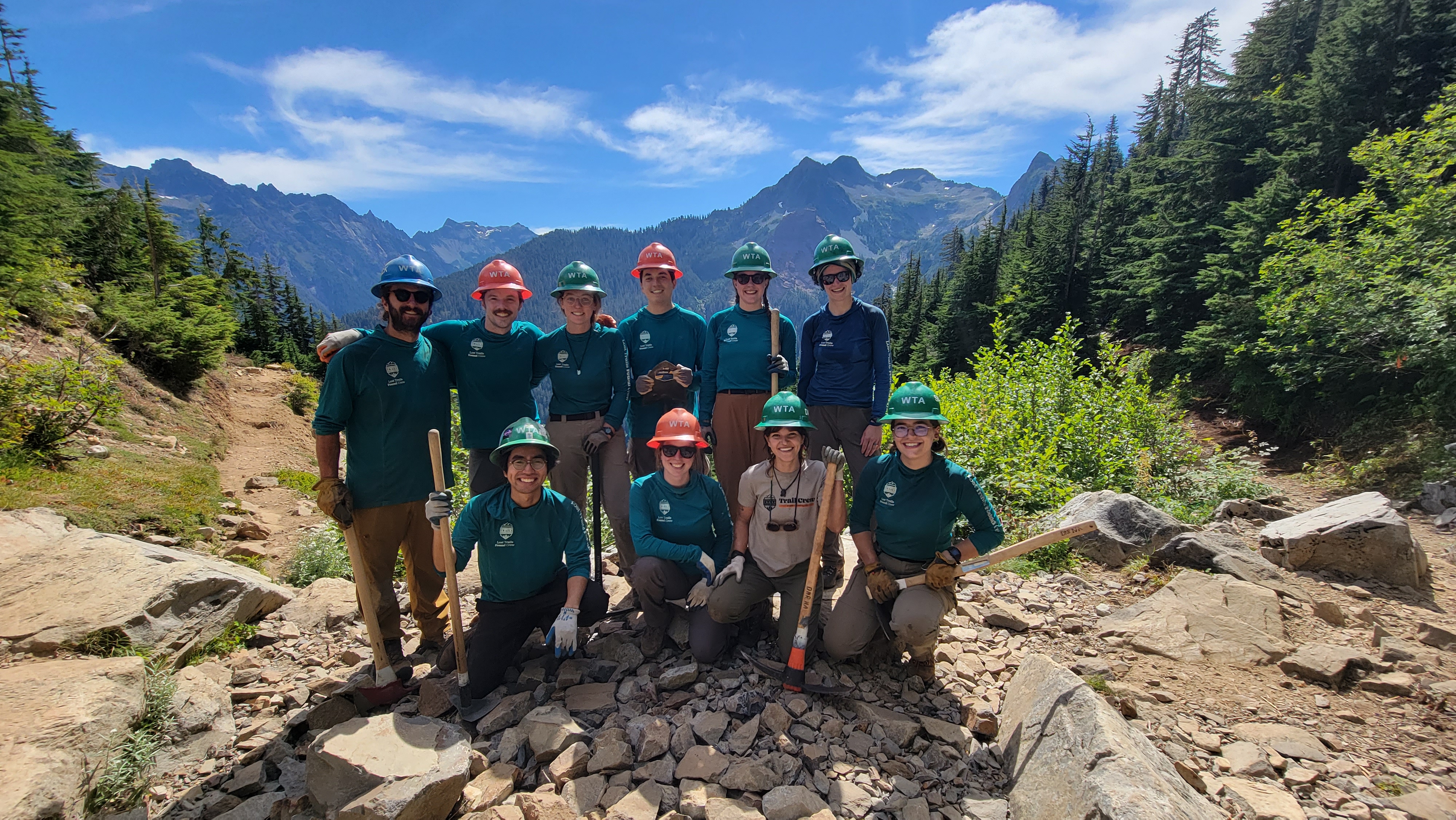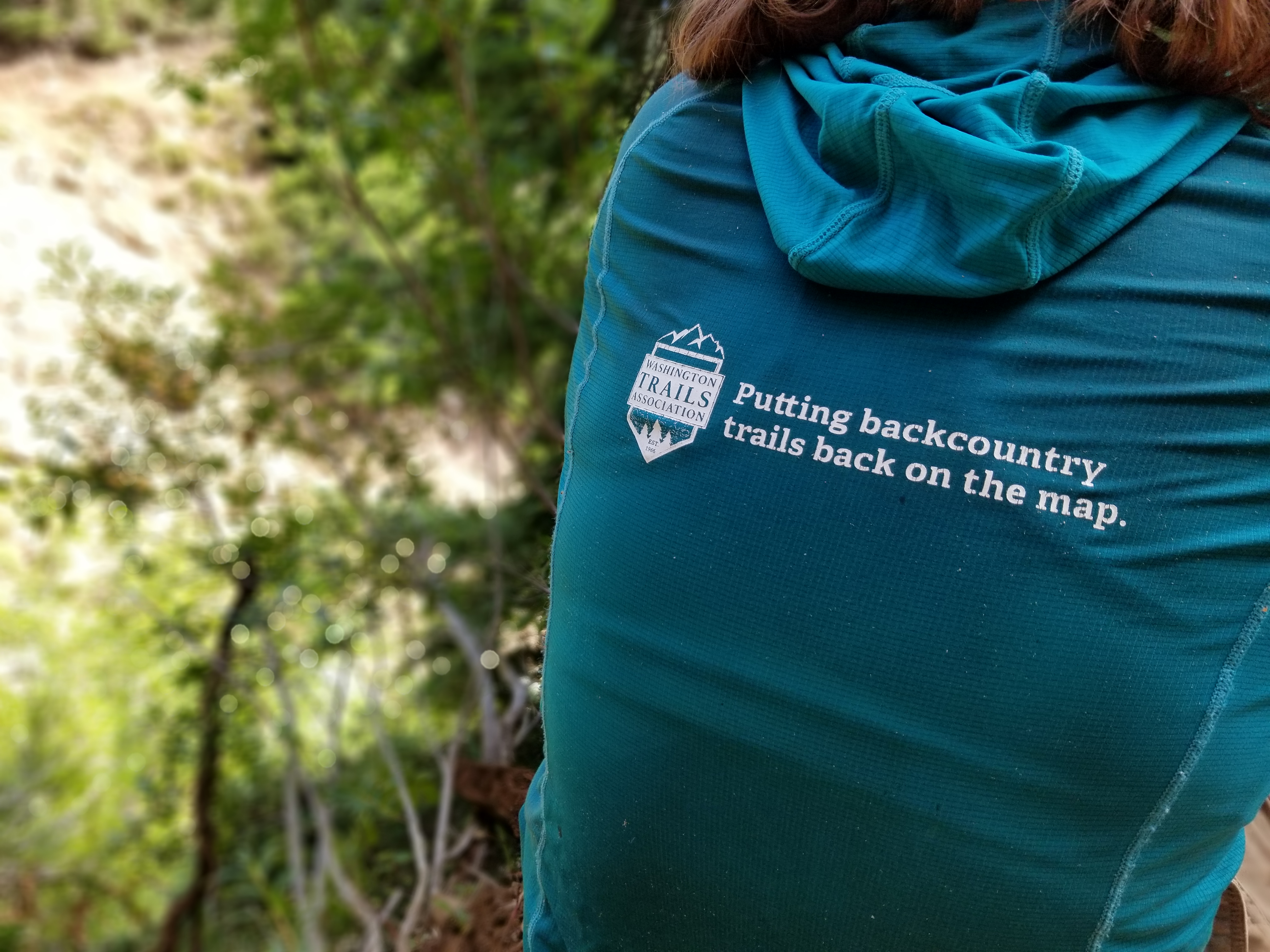Highlights of the 2023 Lost Trails Found Season
WTA's Lost Trails Found crews have been busy this season. We checked-in to see what they've been up to. | By Joseph Gonzalez
Washington is full of diverse landscapes and rich ecosystems, each with its own unique set of needs. Luckily for backcountry trails, WTA’s Lost Trails Found crews have a variety of tools — both literally and in experience — to tackle even the trickiest of projects. Our trail maintenance crews are restoring access to key locations back to usable status after natural disasters or years of neglect. The goal: to ensure Washington’s treasured backcountry landscapes remain accessible for generations to come.
That’s why land managers statewide have asked for our help on everything from restoring lost trails like those in the Schneider Springs Fire recovery zone, to refurbishing old favorites like the Washington Department of Natural Resources’ managed Gothic Basin.
Like a day of brush work in the sun, the summer backcountry trail maintenance season is long. Let’s take a moment to survey our work so far.

Lost Trails Found crews join forces in the backcountry. Photo by Joseph Gonzalez
Lost Trails Found crews are stronger together
Clearing fallen trees from trails is a theme statewide. Crewmember Savanna Lopez mentioned “our hitch on the Hidden Lakes Trail was quite a treat. We had dramatic views the entire time, plus we got out a lot of logs (I think our count came to 475). It was satisfying work.”
A single wildfire burn scar can contain hundreds of blowdowns, which are trees that have come down across the trail. So, how does a crew track the number of logs they clear? “Each person keeps count of how many logs they cut, but we only count logs that are 3 inch diameter across,” says Lopez.
Crewmember Daisy Torres adds: “We keep tallies everyday. In one day I was able to do around 30 logs in the Pasayten. So, if you multiply that by six (crewmembers), we were doing over 100 logs daily. Being able to clear the trail and hike past the stuff that used to be in the way is really cool.”
Earlier in the summer, Mt. Baker-Snoqualmie National Forest contracted our crews to help input a staircase at Pratt Lake this summer. “Rock work is a passion of mine. I’ve worked on a lot of staircases and retaining walls”, says crewmember Kiana Smith.
“I was able to bring that skill set to the team. We managed to build eight steps over our four-day hitch. It’s fun to see everyone get excited about rock work and learn how to use rock bars and picks and make crush.” Crush is small chunks of rock, often used to help tread and prevent erosion.

Just like how each tool is best for a specific job, each crewmember brings a unique set of skills to the program. Photo by Joseph Gonzalez
The season is a marathon, not a sprint
By the end of the 2023 backcountry season our Lost Trails Found crews will have conducted at least 25 hitches, each ranging from four to seven days in length. Between the sheer volume of work and the type of work our crews are operating, it’s critical that the wellness of these crews remains a top priority. Not just regarding safety in the places they work — which are often hazardous burn scars that are home to hundreds of *widowmakers, dead trees or branches in danger of falling on someone below — but also for mental health. Operating in these zones can be a grim reminder of the climate crisis trails in Washington and communities across the globe are dealing with.

Logouts in areas ravaged by fires, like Hidden Lakes, can be a lot of work. Photo by Zachary Sklar
Crewmember Zenwa Shimabukuro reflects: “There’s a lot of work that needs to be done. Take the Hidden Lakes Trail. There’s so much log-out to be done, we haven’t actually cleared the trail to the lake. One day, we’ll find the hidden lake!” As fires are burning hotter and bigger it can be challenging for land managers and trail crews to reach every trail that needs help.
Trail maintenance in these areas is taxing work. That’s why having fun as a team, preventing burn-out and fostering a sense of belonging is such a key component to the culture of Washington Trails Association, even deep in the backcountry.
“We love to go swimming if there’s water available. Inevitably, it always turns into a fun game,” shares Torres. “At Pratt Lake we played a few children's games in the water. There was even some impromptu synchronized swimming. It’s a great way to unwind after work and cool down at the same time.”
When there’s no swimming spot available, the crews will look to break a mental sweat instead with a card game or brain teaser.

The backcountry trail maintenance season is long. Our crews appreciate a chance to take a break and bond. Photo by Joseph Gonzalez
“Zack (the Lost Trails Found crew leader) just introduced us to Hanabi. It’s a teamwork game on little cards,” explains Smith. “It’s really fun. Crosswords are definitely our go-to though.”
“We’re really into crosswords this year. We do a few each week. There’s always some little word that sticks out that becomes an inside joke for the whole hitch,” adds Lopez.
Smith jokes, “In the Entiat, we’d solve the crosswords from inside our tents. Occasionally we’d just shout across the way, ‘Do you guys know a four letter word for (whatever)?’. It’s really fun and a good bonding experience.”
Passion for trails is a key motivator of this work, but it’s the sense of community that bridges the gaps in geography and lifestyle from crewmember to crewmember. Kiana Smith, who originally discovered WTA through Kyvan Elep, another crewmember and former college classmate.
“I was looking for professional opportunities in trail work and found the Lost Trails Found program on the WTA website. I saw Kyvan’s picture on the website and reached out to him. He recommended it ... I interviewed, and I’m here now,” says Smith. “I knew Daisy before this too. We (Smith, Torres and Elep) all studied environmental science and policy in college together. It feels like we’re making an actual difference in the world, which is really cool.”
Impacts on trail
The Lost Trails Found crews are trail maintenance professionals. Not only does this allow them to work on trickier projects in more hazardous areas — it also means career development for their trade. Celebrating its 30th year in 2023, WTA’s trail maintenance program is one of the largest in the nation.
Lopez: “A lot of people don’t realize this is an actual job and career you can advance in. The work lasts a long time and it’s important. If people don’t maintain trails, then trails get lost and we lose access to gorgeous places.”

Backcountry hikers love running into our crews. Photo by Zachary Sklar
Hikers local to these worksites are appreciative. Many Lost Trails Found crewmembers can recall a specific moment (or many) of camaraderie with a hiker while on a hitch.
Shimabukuro recalls, “We didn’t see anybody for the whole time at Hidden Lakes. Then, on the second to last day a hiker who has been going there consistently noticed our work and really appreciated it. He even wrote a thank-you note with a burn stick on a log. We saw it when we hiked out. Also it was LNT approved!”
The impact felt on these trails is immediate for hikers. But, there are also impacts for the hard-working crew members who spend their summers restoring trails in danger of falling off the map. They hone their professional practice, and the work can lead to professional opportunities for years to come.
WTA’s Lost Trails Found crews end their season in late October — when the leaves have changed and the days are shorter. They’ll finish their last hitches in the Naches ranger district before putting a stamp on 2023. Then they can shift gears and look forward to the Lost Trails Found 2024 season, which begins hiring in early October.


Comments